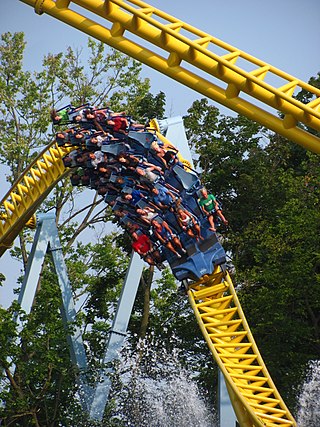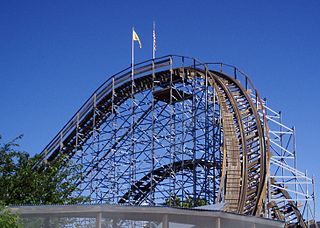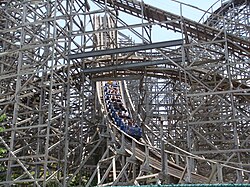Alabama Adventure & Splash Adventure is a water park and amusement park in Bessemer, Alabama. It is owned by Koch Family Parks, which consists of members of the family who formerly had minority ownership in Holiday World & Splashin' Safari.

Kingda Ka is a hydraulically-launched steel roller coaster located at Six Flags Great Adventure in Jackson, New Jersey, United States. Manufactured by Intamin and designed by Werner Stengel, Kingda Ka opened as the tallest roller coaster in the world on May 21, 2005, surpassing Top Thrill Dragster. It is the second strata coaster ever built, exceeding 400 feet (120 m) in height. Both were made with similar designs, although Kingda Ka's layout adds an airtime hill on the return portion of the track.

Incredicoaster is a steel launched roller coaster located at Disney California Adventure in Anaheim, California, United States. Manufactured by Intamin, the ride was originally opened to the public as California Screamin' in early 2001. It is the only roller coaster with an inversion at the Disneyland Resort and it is the fastest, reaching a maximum speed of 55 mph (89 km/h). With a track length of 6,072 feet (1,851 m), Incredicoaster is the sixth-longest steel roller coaster in the world.

Six Flags Great America is a 304-acre (123 ha) amusement park located in Gurnee, Illinois, within the northern Chicago metropolitan area. The amusement park originally opened as Marriott's Great America on May 29, 1976, as one of two theme parks built by the Marriott Corporation. Six Flags acquired the amusement park in 1984 after the theme park division was an earnings disappointment for Marriott. The sale gave Six Flags rights to the Looney Tunes intellectual properties.

Batman: The Ride is an inverted roller coaster based on the DC Comics character Batman and found at seven Six Flags theme parks in the United States. Built by consulting engineers Bolliger & Mabillard, it rises to a height of between 100 and 105 feet and reaches top speeds of 50 mph (80 km/h). The original roller coaster at Six Flags Great America was partially devised by the park's general manager Jim Wintrode. Batman: The Ride was the world's first inverted roller coaster when it opened in 1992, and has since been awarded Coaster Landmark status by the American Coaster Enthusiasts. Clones of the ride exist at amusement parks around the world.

GhostRider is a wooden roller coaster at Knott's Berry Farm in Buena Park, California. It is located in the Ghost Town section of the park, south of the main entrance. Manufactured by Custom Coasters International, GhostRider is the tallest and longest wooden coaster on the West Coast of the United States, measuring 4,533 feet (1,382 m) long and 118 feet (36 m) tall. The ride follows an L-shaped double out and back pattern, with a station themed to a mining building. There are three trains, each themed to a different precious metal, though only two are in use at any given time.

The Cyclone, also called the Coney Island Cyclone, is a wooden roller coaster at Luna Park in Coney Island, Brooklyn, New York City. Designed by Vernon Keenan, it opened to the public on June 26, 1927. The roller coaster is on a plot of land at the intersection of Surf Avenue and West 10th Street. The Cyclone reaches a maximum speed of 60 miles per hour (97 km/h) and has a total track length of 2,640 feet (800 m), with a maximum height of 85 feet (26 m).

Raging Bull is a steel roller coaster located at Six Flags Great America in Gurnee, Illinois. Designed by Werner Stengel and manufactured by Bolliger & Mabillard (B&M), the ride opened to the public on May 1, 1999. It features a 208-foot (63 m) first drop, a maximum speed of 73 mph (117 km/h), and a track length of over 5,000 feet (1,524 m). It was the second B&M Hyper Coaster model to open in the United States, closely following the opening of Apollo's Chariot at Busch Gardens Williamsburg.

Alpengeist is an inverted roller coaster located at Busch Gardens Williamsburg in Williamsburg, Virginia. Manufactured by Bolliger & Mabillard, Alpengeist has an Alpine mountain region theme and opened in 1997 as the tallest inverted coaster in the world. The name "Alpengeist" is German for "Ghost of the Alps" or "Alpine Spirit", and the ride is themed to a runaway ski lift. It has the records for the tallest complete circuit inverted coaster in the world, tallest inverted roller coaster in the United States, and the longest complete circuit coaster drop in the world.

El Toro is a wooden roller coaster located at Six Flags Great Adventure in Jackson Township, New Jersey. Designed by Werner Stengel and manufactured by Intamin, the ride opened to the public on June 11, 2006. Intamin subcontracted Rocky Mountain Construction to build the ride, and the coaster's track was prefabricated, allowing for quicker installation and lower construction costs. El Toro is the main attraction of the Mexican-themed section of the park, Plaza Del Carnaval. It replaced another roller coaster, Viper, which closed following the 2004 season.

Kraken is a steel roller coaster located at SeaWorld Orlando in Florida, United States. Manufactured by Bolliger & Mabillard, the ride opened as the second longest floorless coaster in the world on June 1, 2000, with a track length measuring 4,177 feet (1,273 m). It features a total of seven inversions and reaches a maximum speed of 65 mph (105 km/h). The coaster was named after a fictional sea monster of the same name. In late 2016, Kraken underwent a refurbishment and reopened as Kraken Unleashed in June 2017. A virtual reality experience was added to the ride, but due to technical difficulties and extensive wait times, the feature was permanently removed the following year.

Iron Gwazi is a steel-track hybrid roller coaster at Busch Gardens Tampa Bay, a theme park in Tampa, Florida, United States. Development of the original Gwazi began in July 1998, when Busch Gardens announced that it would build a wooden roller coaster on land formerly occupied by the Anheuser-Busch brewery. Great Coasters International (GCI) built Gwazi, a wooden dueling roller coaster with two separate tracks. The ride was named after a fabled creature with a tiger's head and a lion's body. Trains riding on both tracks, respectively named Lion and Tiger, reached a height of 105.4 feet (32.1 m) and a maximum speed of 51 mph (82 km/h).

The Boss is a wooden roller coaster located in the Britannia section of Six Flags St. Louis in Eureka, Missouri. It opened on April 29, 2000, and was manufactured by Custom Coasters International. It features a lift hill height of 122 feet (37 m) and a first drop of 150 feet (46 m). Prior to the 2018 season, it also featured a 570-degree helix.

Wildcat's Revenge is a hybrid roller coaster located at Hersheypark in Hershey, Pennsylvania, United States. The ride originally opened in 1996 as Wildcat, a wooden coaster manufactured by Great Coasters International (GCI). The wooden coaster was the first from GCI and served as the anchor attraction of the Midway America section of the park. It cost $5.6 million to construct and was built on a 2-acre (0.81 ha) plot of land that had previously been used for parking. The ride traversed a 90-foot lift hill and twelve banked turns, subjecting riders to forces of up to 3.5 Gs. From 1998 to 2009, Wildcat ranked among the top 50 wooden roller coasters in the annual Golden Ticket Awards publication from Amusement Today. Wildcat initially received critical acclaim, but it gained a negative reputation for its increasing roughness.

Recoil is a Boomerang roller coaster located at Wonderla in Raviryal, Hyderabad, India. It was previously located at Alabama Adventure as Zoomerang until new management in 2012 decided to remove its rides and solely operate as a water park called "Splash Adventure". It also operated at Wonderland Sydney as The Demon after being relocated from World Expo Park. The ride was removed in 2013 and sold to Wonderla in India where it was renamed "Recoil".

Project 305 is a steel roller coaster located at Kings Dominion in Doswell, Virginia, United States. Manufactured by Intamin, the ride opened to the public as Intimidator 305 on April 2, 2010. Themed to racing, the coaster was originally named after the late NASCAR driver Dale Earnhardt, who was commonly known as "The Intimidator". It is located in the Jungle X-Pedition section of the park near Anaconda on the former site of the Safari Monorail ride. Standing at 305 feet (93 m) tall and reaching speeds up to 90 mph (145 km/h), it is the second giga coaster to be built in North America, following Millennium Force at Cedar Point. The $25-million investment was the most expensive of any ride in park history and the 14th coaster to debut at the park.

Skyrush is an Intamin prototype Wing Coaster at Hersheypark in Hershey, Pennsylvania, United States. It opened to the general public on May 26, 2012, as Hersheypark's 12th roller coaster and the park's third coaster made by Intamin. Skyrush features a 200 ft (61 m) cable lift that raises the train at 26 ft/s (480 m/min). The roller coaster is located in the Hollow section of Hersheypark, next to the Comet wooden coaster; Skyrush itself is mainly set above Spring Creek.
This is a list of events and openings related to amusement parks that occurred in 2011. These various lists are not exhaustive.
This is a list of events and openings related to amusement parks that have occurred in 2012. These various lists are not exhaustive.

New Mexico Rattler is a wooden roller coaster located at Cliff's Amusement Park in Albuquerque, New Mexico. The roller coaster was designed and manufactured by Custom Coasters International (CCI); the park completed the attraction after CCI went bankrupt in July 2002. The New Mexico Rattler opened on September 28, 2002, having cost $2 million. The roller coaster reaches a maximum height of 80 feet (24 m), with a maximum speed of 47 mph (76 km/h) and a total track length of 2,750 feet (840 m).

















